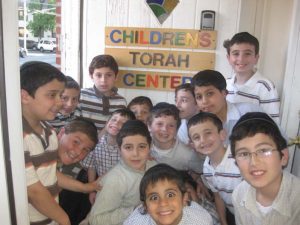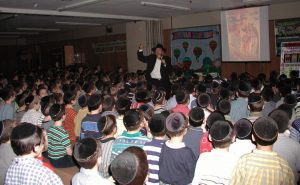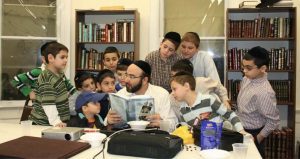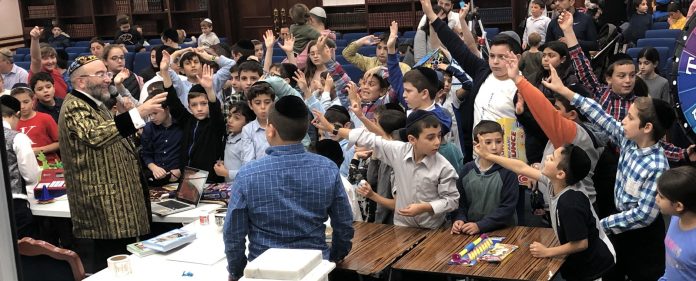Machla Abramovitz
No matter what the season, whether in the cold of winter or the heat of summer, hundreds of children – boys and girls – drop whatever they are doing and rush to partake of what Rabbi Maimon Elbaz is dishing out.
What are these delights streaming from this colorfully-attired melamed’s bag of tricks? Are they ice cream, cookies, or other delectables?
Actually, no.
They are “mussar schmoozes” (religious discourses). But tell anyone participating in his “Torah Shows” that that is what they are consuming, and they will look at you as if you descended from some strange faraway galaxy. “Mussar? Impossible! What Rabbi Elbaz is presenting is way too much fun for that.”
But that is, precisely, what it is – profound Torah insights cloaked in the most luscious wrappings.
“Seeing” What the Words are Saying
Take Rabbi Elbaz’s Shemitah Show as one example. Vibrantly colorful slides of lush fields and dripping fruit glide across the screen, accompanying Rabbi Elbaz’s engaging narrative as he takes his audience on a virtual tour of Israel as seen through the eyes of a farmer observing shemitah. But as the children soon learn, this presentation is not only about farmers living far away in a land few of them ever visited, but about themselves and their relationship to Hashem.
“During shemitah, I can go into a stranger’s field and help myself to all the fruits my family can eat for three days,” Rabbi Elbaz informs, his voice undulating with drama and meaning.
Then, a child, chosen previously from the audience, interrupts the rabbi’s monologue with questions that everyone is eager to ask.
“Three days?” this charming little voice chirps. “I’m going to take enough for my family for an entire month!”
“No,” the rabbi replies, his voice oozing with authority. “We are only allowed to take three days’ worth of food.”
Consider the lessons taught in this short exchange. These elated youngsters learn not only some laws of shemitah, but also about hesed (kindness) and emunah. We needn’t take more than our share because we need to understand that Hashem provides all our needs.
“By answering targeted questions that I know children ask themselves, and by doing it in a fun way,” Rabbi Elbaz says, “I help ensure that the children will remember the lessons taught much longer.”
Rabbi Elbaz tackles not only timely subjects like shemitah, but also “evergreen” topics such as geulah (redemption), Shabbat, Torah learning, gedoleh Yisrael (great Torah sages), and others – each one similarly developed as a labor of love.
The rabbi’s all-time favorite show is the one about the Amidah prayer, also known as the Shemonah Esreh. We recite this prayer three times a day, but do we concentrate on every one of the 18 berachot (blessings) as we should? More of us certainly will after experiencing Rabbi Elbaz’s slide show on this prayer. By watching his real-life photos of blessings that we often take for granted – freshwater, a happy family, the ability to hear – davening takes on more profound, immediate, and personal meaning.
“It’s not enough to only hear the words of the davening,” the rabbi explains. “My audiences ‘see’ what the words are saying. My goal is to make them feel a deeper connection to Hashem in a fun way. My audience – children and adults – is so immersed in the experience that they feel compelled to do the mitzvah.”
This master storyteller has created, over the last 30 years, 24 interactive and technologically laden Torah Shows aimed at bringing significant Torah lessons to his audiences. Rabbi Elbaz is also occasionally invited to entertain and inspire groups, and runs an ongoing Game Show of Q&A to challenge the minds of young and old. He has traveled to over 50 cities, visiting high schools, elementary schools, and shuls, presenting his meaningful Torah Shows Series.
A Master Educator Since Childhood
Most educators will tell you that in our age of technology and instant gratification, keeping students engaged is exceedingly difficult. But Rabbi Elbaz never found this to be the case. Even before his bar mitzvah, while living in Cleveland, Ohio, the young Maimon ran Pirchei, Agudath Israel’s youth group for boys, at the Telshe Yeshiva. As a precursor to his future success as a melamed, Maimon packed his Shabbat programs with captivating programs.

Later, when running the canteen at Telshe Yeshiva and Camp Kol Torah, he added brain teasers to his repertoire in the form of Torah riddles to initiate conversations with the children on Torah, fear of Heaven, and other subjects. Those who solved these teasers received free pizza and popcorn. He also loved giving out goldfish to recruits.
“Sure, they enjoyed the chance to win a treat,” Rabbi Elbaz recalls, “but they were more pleased to realize that the Torah lessons they learned would profoundly impact their daily lives.”
Noting how children gravitated towards young Maimon (they called him “the Pied Piper,”) the Rosh Yeshiva of Telshe, Rav Mordechai Gifter, zt”l, predicted – accurately – that he would do great things in the world of hinuch (education).
Today, this proud father and grandfather is a fifth-grade rebbe at Yeshivat Ziv HaTorah, and an 11th-grade English Language Arts teacher at Yeshivat Kinyan Torah (YKT), reflecting his love of Torah and abundant artistic and creative abilities. Meanwhile, his extracurricular programs keep thousands of talmidim/fans engaging in Torah study and pursuing a meaningful relationship with Hashem. His classes are available on TorahAnytime.com/kids.
The Merging of Two Worlds
The journey Rabbi Elbaz traveled to arrive at his phenomenal success reflects his unique connection to both the Sephardic and Ashkenazi communities.
The rabbi grew up in a Sephardic home, but his schooling and friendships developed in a decidedly Ashkenaz environment – Telshe in Cleveland and Chicago, and Ner Yisroel in Baltimore. Then, in 1988, Rabbi Avraham Baddouch and Rabbi Shlomo Goldberg invited him and other Sephardic bochurim to Mexico City to help strengthen their growing Sephardic yeshiva, Emek.
Rabbi Elbaz recalls that he found, to his sheer delight, that the community there in Mexico City did not need help, but was in “turbo drive” in its pursuit of Torah knowledge.
“We came to provide hizuk [strengthening],” he says, “but we received more than we gave.”
The community’s impact on him was so substantial that he later looked to the Sephardim for a wife, and he married Malky Vicki Salem, the granddaughter of Hacham Sion and Victoria Maslaton, who encouraged the couple in their respective missions – for him, hinuch, and for his wife, hesed and shadchanut (matchmaking).
His stay in Mexico also pushed him to attend Yeshivat Mikdash Melech, a Sephardic yeshiva in Jerusalem, and he later joined Camp Shivtei Yisrael, an all-Sephardic sleepaway camp in Upstate NY where campers were immersed in a yeshiva environment for two months. He was particularly impressed by how patient the staff was with campers from families that were not religiously observant. He realized that this kind of awareness and sensitivity best reflected who he wanted to be.


“They Came Because They Felt Loved”
Putting this inspiration into action, Rabbi Elbaz opened the Children’s Torah Center, a father-and-son Shabbat program housed in the Ahi Ezer Torah Center. It later expanded to every second day of the week, and ran for 12 incredible years.
“It was not a babysitting service,” Rabbi Elbaz says, “but a real extracurricular enrichment program. We had a full-functioning minyan, speeches, and a Mishnayot program, all under the auspices of this wonderful shul.”

Some 100 children attended every program, and they were enamored. The atmosphere was magical. The rooms were replete with electronics, sporting goods, Torah tapes, and all kinds of exciting goodies that they could win.

on Shabbatot at Young Ahi Ezer.
The program featured Rabbi Elbaz’ famous Torah riddles, over 3,000 of which he later compiled into his popular two-volume book titled Torahific, which he dedicated to his late parents, Rabbi Avraham and Esther Elbaz a”h. The riddles included questions like, “Where in the Torah is it hinted not to overeat candy, nosh, and sweets?”; “When does a ‘little’ equal ‘a lot,’ and sometimes even more?”; and, “When is hametz forbidden even when it’s not Pesach? And why?” These questions had children, fathers, and grandfathers scratching their heads.
“The program was dynamic, exciting, and well organized,” Rabbi Elbaz proudly recalls. “But more significantly, the children came because they felt loved. Whether a child had peyot or wore a necklace, we equally welcomed them to the program.”
The Center has since moved to Congregation Har Halevanon at 820 Ave. S, and runs every Sunday afternoon.
Books on the weekly parashah and Navi shortly followed. His latest volume, The Children’s Sefer Torah Encyclopedia, is a colorful compilation of information – culled from Torah, Midrash, and the Talmud – on making a Sefer Torah, replete with quality photos. He also produced an hour-long Torah Show on this subject.
Rabbi Elbaz says his books, Torah Shows and Shabbat/Sunday programs ultimately serve a greater purpose: to win over the hearts of his audiences, inspiring them to live a Torah lifestyle. “We keep telling our youth what not to watch, so we must create for them alternative materials. If they’re entertained and inspired, they won’t go searching outside the Torah community.”
But when it comes to keeping children engaged, he says, there is no great secret to it all.
“Children want to feel that their rebbe is sensitive to who they are, does not embarrass them, and praises them honestly.” All this comes naturally to Rabbi Elbaz, setting an example for all educators and parents to follow.



